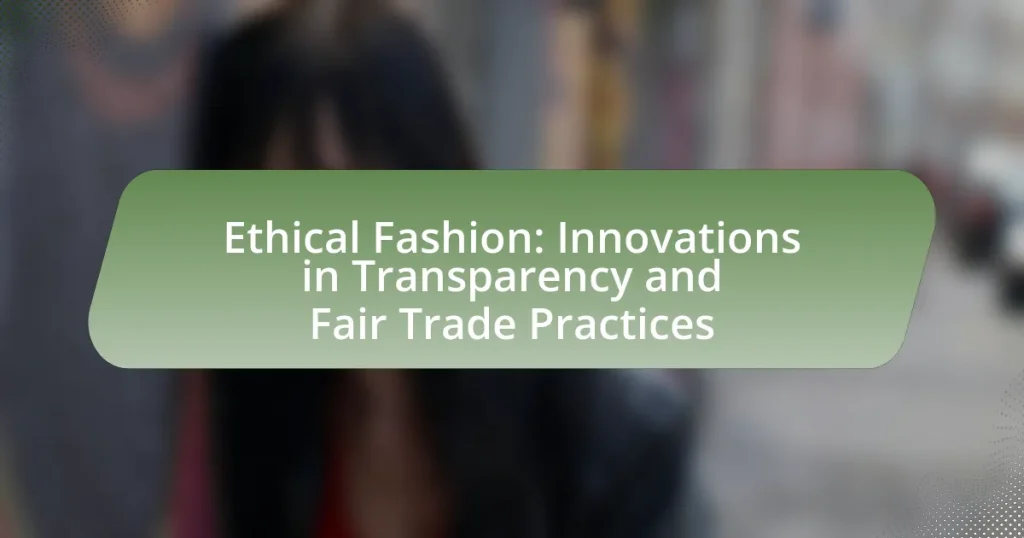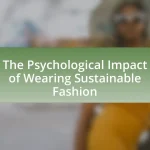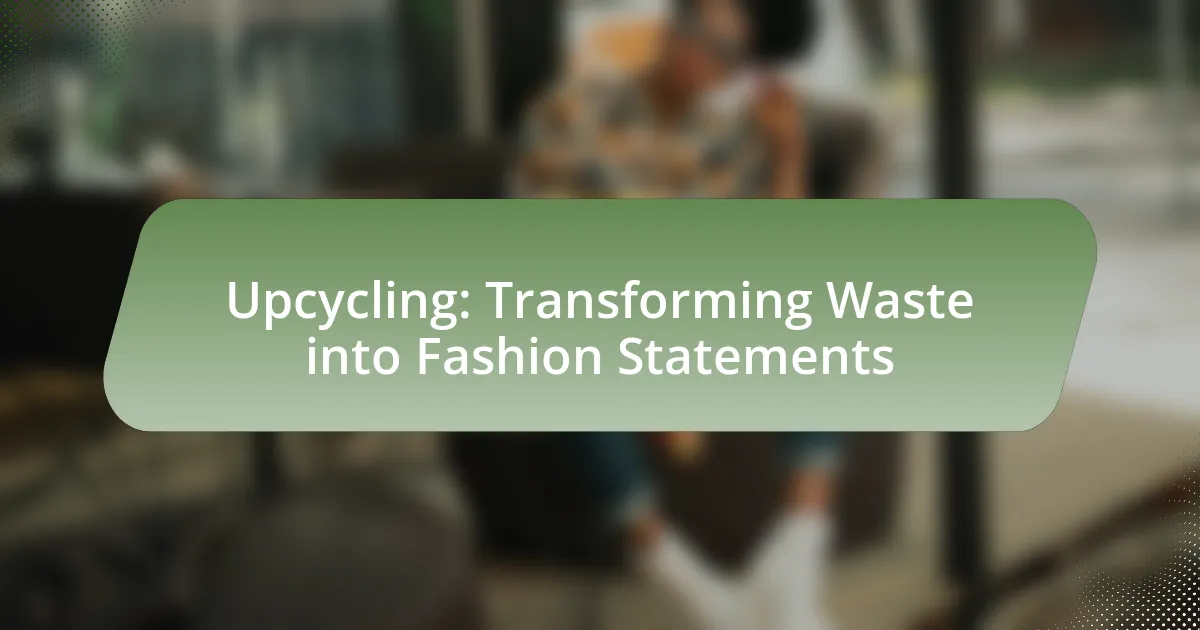Ethical fashion is defined as clothing and accessories produced with a focus on social and environmental responsibility, emphasizing fair labor practices, sustainable materials, and transparent supply chains. The article explores the differences between ethical and traditional fashion, highlighting key principles such as sustainability and transparency, and the importance of fair trade practices. It discusses innovations driving ethical fashion, including blockchain technology and sustainable materials, while addressing challenges like high production costs and consumer awareness. Additionally, the article outlines practical steps consumers can take to support ethical fashion, such as researching brands and choosing sustainable options.
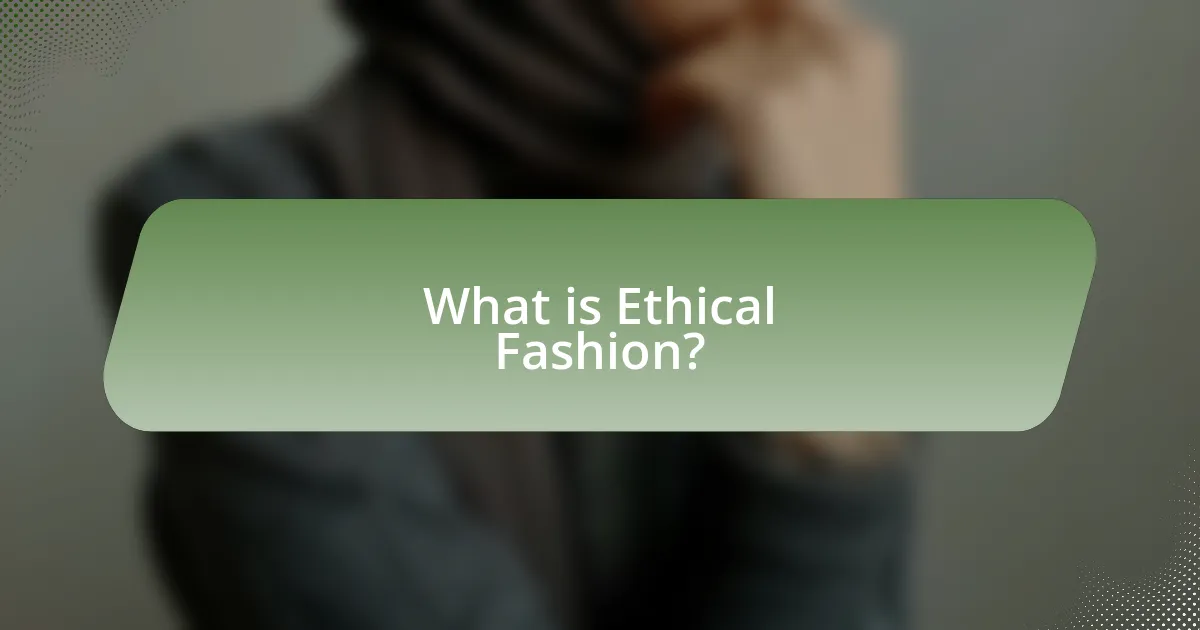
What is Ethical Fashion?
Ethical fashion refers to clothing and accessories produced in a manner that prioritizes social and environmental responsibility. This approach encompasses fair labor practices, sustainable materials, and transparent supply chains. For instance, brands that engage in ethical fashion often ensure that workers receive fair wages and work in safe conditions, while also minimizing their environmental impact through eco-friendly materials and processes. The global ethical fashion market was valued at approximately $6.35 billion in 2020 and is projected to grow, reflecting increasing consumer demand for responsible production practices.
How does Ethical Fashion differ from traditional fashion?
Ethical fashion differs from traditional fashion primarily in its commitment to sustainability and social responsibility. While traditional fashion often prioritizes profit and rapid production, ethical fashion emphasizes fair labor practices, environmentally friendly materials, and transparency in the supply chain. For instance, ethical brands typically ensure that workers receive fair wages and work in safe conditions, contrasting with traditional practices that may exploit labor for lower costs. Additionally, ethical fashion often utilizes organic or recycled materials, reducing environmental impact, whereas traditional fashion frequently relies on synthetic fabrics that contribute to pollution. This distinction highlights the growing consumer demand for responsible practices in the fashion industry.
What are the key principles of Ethical Fashion?
The key principles of Ethical Fashion include sustainability, fair labor practices, and transparency in the supply chain. Sustainability focuses on minimizing environmental impact through the use of eco-friendly materials and processes, which is essential as the fashion industry is responsible for significant pollution and waste. Fair labor practices ensure that workers are paid fair wages and work in safe conditions, addressing the exploitation often seen in garment production. Transparency in the supply chain involves clear communication about sourcing, production methods, and labor conditions, allowing consumers to make informed choices. These principles are supported by various organizations and certifications, such as the Global Organic Textile Standard (GOTS) and Fair Trade, which promote ethical practices within the industry.
Why is Ethical Fashion important in today’s society?
Ethical fashion is important in today’s society because it promotes sustainable practices and social responsibility within the fashion industry. This movement addresses critical issues such as environmental degradation, labor exploitation, and the need for transparency in supply chains. For instance, the fashion industry is responsible for 10% of global carbon emissions and significant water pollution, highlighting the urgent need for sustainable alternatives. Furthermore, ethical fashion advocates for fair wages and safe working conditions for garment workers, as evidenced by the 2013 Rana Plaza disaster, which underscored the dangers of neglecting labor rights. By prioritizing ethical fashion, consumers can drive demand for responsible production methods, ultimately fostering a more equitable and sustainable world.
What are the main components of Ethical Fashion?
The main components of Ethical Fashion include sustainable sourcing, fair labor practices, and transparency in the supply chain. Sustainable sourcing involves using eco-friendly materials and processes that minimize environmental impact, such as organic cotton or recycled fabrics. Fair labor practices ensure that workers receive fair wages, safe working conditions, and the right to unionize, which is supported by organizations like the Fair Trade Foundation. Transparency in the supply chain means that brands disclose information about their production processes and labor conditions, allowing consumers to make informed choices. These components collectively contribute to a more responsible and ethical approach to fashion.
How do transparency and traceability play a role in Ethical Fashion?
Transparency and traceability are fundamental to ethical fashion as they ensure accountability and foster consumer trust. Transparency allows brands to openly share information about their supply chains, including labor practices and sourcing materials, which helps consumers make informed choices. Traceability enables the tracking of products from raw materials to finished goods, ensuring that ethical standards are upheld throughout the production process. For instance, a 2021 report by the Fashion Transparency Index found that only 40% of major fashion brands disclose their suppliers, highlighting the need for improved transparency to combat unethical practices. By prioritizing these elements, ethical fashion brands can demonstrate their commitment to sustainability and social responsibility, ultimately influencing consumer behavior and industry standards.
What is the significance of fair trade practices in Ethical Fashion?
Fair trade practices are significant in Ethical Fashion as they ensure fair wages and safe working conditions for garment workers. These practices promote social equity by providing producers in developing countries with a stable income, which can lead to improved community development and reduced poverty. For instance, according to the World Fair Organization, fair trade can increase farmers’ incomes by 20-50%, enabling them to invest in education and healthcare. Additionally, fair trade certification often requires environmentally sustainable practices, aligning with the broader goals of Ethical Fashion to minimize ecological impact.

What innovations are driving Ethical Fashion forward?
Innovations driving Ethical Fashion forward include blockchain technology, sustainable materials, and circular economy practices. Blockchain technology enhances transparency in supply chains by providing immutable records of product origins and labor conditions, which helps consumers make informed choices. Sustainable materials, such as organic cotton and recycled polyester, reduce environmental impact and promote responsible sourcing. Circular economy practices, like clothing rental and recycling programs, extend the lifecycle of garments and minimize waste, aligning with ethical consumption principles. These innovations collectively contribute to a more sustainable and equitable fashion industry.
How are technology and innovation enhancing transparency in the fashion industry?
Technology and innovation are enhancing transparency in the fashion industry through the implementation of blockchain, supply chain tracking, and digital platforms. Blockchain technology allows for immutable records of transactions, enabling consumers to verify the origins of materials and the ethical practices of manufacturers. For instance, brands like Everledger utilize blockchain to track the provenance of luxury goods, ensuring authenticity and ethical sourcing. Additionally, supply chain tracking tools, such as RFID tags and IoT devices, provide real-time data on the production process, allowing brands to disclose information about labor conditions and environmental impact. Digital platforms, including apps and websites, empower consumers to access detailed information about a brand’s sustainability practices, fostering informed purchasing decisions. These advancements collectively contribute to a more transparent fashion industry, promoting accountability and ethical practices.
What role do blockchain and digital platforms play in Ethical Fashion?
Blockchain and digital platforms play a crucial role in Ethical Fashion by enhancing transparency and traceability in the supply chain. Blockchain technology allows for immutable records of transactions, enabling consumers to verify the origins of materials and the ethical practices of manufacturers. For instance, brands like Everledger utilize blockchain to track the lifecycle of products, ensuring that they are sourced sustainably and produced under fair labor conditions. Digital platforms further facilitate this by connecting consumers directly with ethical brands, promoting informed purchasing decisions. According to a report by the World Economic Forum, the integration of blockchain in fashion can reduce fraud and increase consumer trust, thereby supporting ethical practices in the industry.
How can consumer engagement be improved through innovative practices?
Consumer engagement can be improved through innovative practices by leveraging technology to enhance transparency and foster trust. For instance, brands can utilize blockchain technology to provide consumers with verifiable information about the sourcing and production processes of their products. This approach not only informs consumers but also empowers them to make ethical choices, as evidenced by a study from the Journal of Business Research, which found that 70% of consumers are more likely to engage with brands that demonstrate transparency in their supply chains. Additionally, interactive platforms that allow consumers to participate in the design process or provide feedback can further enhance engagement, as seen in successful campaigns by brands like Adidas, which launched a platform for co-creating products with consumers.
What are some examples of brands leading in Ethical Fashion innovations?
Patagonia, Eileen Fisher, and Reformation are examples of brands leading in Ethical Fashion innovations. Patagonia is known for its commitment to environmental sustainability, using recycled materials and promoting fair labor practices. Eileen Fisher focuses on sustainable sourcing and has implemented a take-back program for its garments, encouraging circular fashion. Reformation emphasizes transparency in its supply chain, providing detailed information about the environmental impact of its products. These brands exemplify the integration of ethical practices in fashion, demonstrating a commitment to sustainability and social responsibility.
Which brands are recognized for their commitment to transparency?
Brands recognized for their commitment to transparency include Patagonia, Everlane, and Reformation. Patagonia is known for its transparent supply chain practices, openly sharing information about its sourcing and production processes. Everlane emphasizes radical transparency by disclosing the true costs behind its products and the factories where they are made. Reformation provides detailed information about the environmental impact of its clothing, including carbon emissions and water usage, allowing consumers to make informed choices. These brands exemplify transparency in the fashion industry through their clear communication and ethical practices.
How do these brands implement fair trade practices effectively?
Brands implement fair trade practices effectively by ensuring equitable compensation for producers, maintaining transparent supply chains, and adhering to ethical labor standards. For instance, companies like Patagonia and Fair Trade Certified prioritize direct trade relationships with farmers and artisans, which allows them to pay fair wages that exceed local minimums. Additionally, these brands often conduct regular audits and provide training to ensure compliance with fair trade standards, thereby fostering sustainable practices. Research from the Fair Trade Foundation indicates that fair trade certified products can lead to a 20% increase in income for farmers, demonstrating the tangible benefits of these practices.
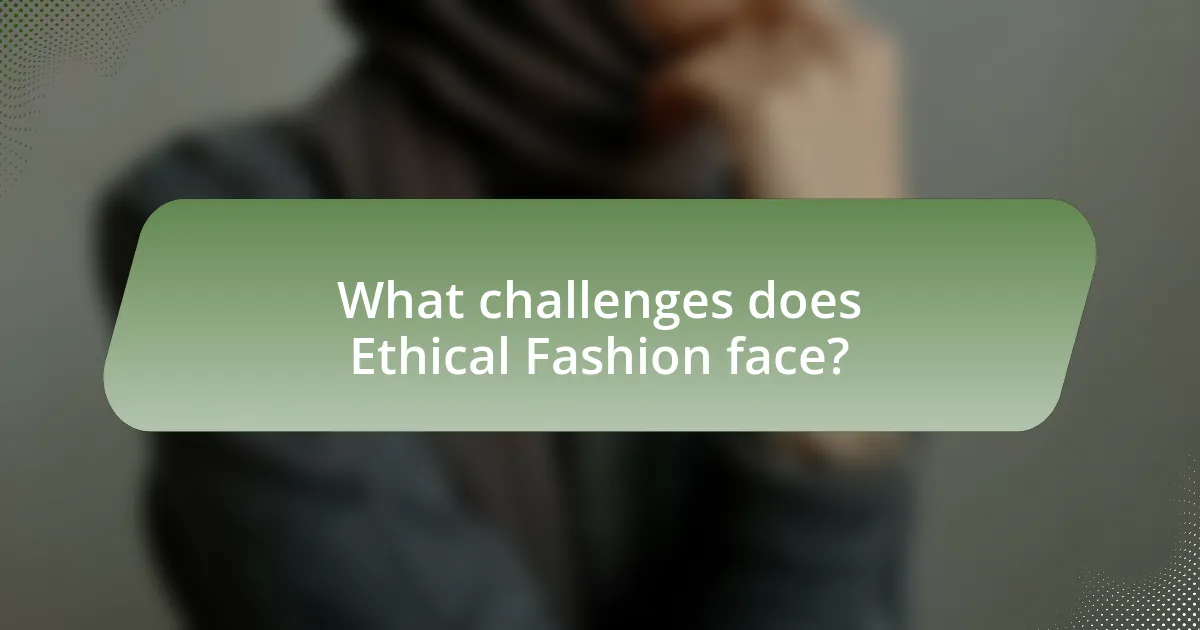
What challenges does Ethical Fashion face?
Ethical fashion faces several significant challenges, including high production costs, lack of consumer awareness, and supply chain transparency issues. High production costs arise from the use of sustainable materials and fair labor practices, which can lead to higher retail prices compared to fast fashion alternatives. Lack of consumer awareness limits demand for ethical products, as many consumers prioritize price over sustainability. Additionally, supply chain transparency issues complicate the verification of ethical practices, making it difficult for brands to prove their commitment to ethical standards. According to a 2021 report by the Ethical Fashion Forum, 60% of consumers are unaware of the impact of their clothing choices on the environment and society, highlighting the need for increased education and awareness in the market.
What are the barriers to achieving full transparency in the fashion industry?
The barriers to achieving full transparency in the fashion industry include complex supply chains, lack of standardized reporting, and resistance from brands. Complex supply chains often involve multiple tiers of production, making it difficult to trace the origins of materials and labor practices. A lack of standardized reporting means that companies may disclose information inconsistently, leading to confusion and mistrust among consumers. Additionally, many brands resist transparency due to fears of negative publicity or competitive disadvantage, which hinders efforts to provide clear and honest information about their practices. These factors collectively impede the industry’s ability to achieve full transparency.
How do economic factors impact the adoption of fair trade practices?
Economic factors significantly influence the adoption of fair trade practices by affecting the cost structures and market demand for ethically produced goods. For instance, higher production costs associated with fair trade certifications can deter businesses from adopting these practices, particularly in price-sensitive markets. According to a study by the Fair Trade Foundation, companies that invest in fair trade often face initial financial burdens, but they can benefit from increased consumer demand for ethically sourced products, which can lead to higher profit margins over time. Additionally, economic conditions such as consumer purchasing power and market competition play crucial roles; during economic downturns, consumers may prioritize lower prices over ethical considerations, impacting fair trade adoption negatively.
What role does consumer awareness play in overcoming these challenges?
Consumer awareness plays a crucial role in overcoming challenges in ethical fashion by driving demand for transparency and fair trade practices. When consumers are informed about the ethical implications of their purchases, they are more likely to support brands that prioritize sustainable practices and fair labor conditions. This shift in consumer behavior can compel companies to adopt more responsible practices, as evidenced by a 2021 survey indicating that 66% of global consumers are willing to pay more for sustainable brands. Increased consumer awareness not only fosters accountability among brands but also encourages the industry to innovate in transparency, ultimately leading to a more ethical fashion landscape.
How can the fashion industry address these challenges?
The fashion industry can address challenges related to ethical practices by implementing transparent supply chains and adopting fair trade principles. Transparency can be achieved through blockchain technology, which allows consumers to trace the origin of materials and labor conditions, thereby fostering accountability. For instance, brands like Everlane and Patagonia have successfully utilized transparency to build consumer trust and loyalty. Additionally, adopting fair trade practices ensures that workers receive fair wages and safe working conditions, as evidenced by the Fair Trade Certified label, which has seen a 20% increase in consumer awareness since 2018. By prioritizing these strategies, the fashion industry can effectively tackle ethical challenges and promote sustainable practices.
What strategies can brands adopt to enhance transparency and fair trade?
Brands can enhance transparency and fair trade by implementing supply chain traceability, engaging in third-party certifications, and fostering direct relationships with producers. Supply chain traceability allows brands to track the origin of materials and labor practices, ensuring ethical sourcing. For instance, brands like Patagonia utilize blockchain technology to provide consumers with detailed information about their products’ journey from raw materials to finished goods. Third-party certifications, such as Fair Trade or Global Organic Textile Standard, validate a brand’s commitment to ethical practices, providing consumers with assurance of compliance with fair trade standards. Additionally, fostering direct relationships with producers empowers communities and ensures fair compensation, as seen in brands like TenTree, which collaborates directly with tree-planting initiatives. These strategies collectively promote accountability and build consumer trust in ethical fashion.
How can collaboration among stakeholders improve Ethical Fashion practices?
Collaboration among stakeholders can significantly improve Ethical Fashion practices by fostering shared responsibility and enhancing transparency throughout the supply chain. When brands, manufacturers, consumers, and NGOs work together, they can establish common standards and practices that prioritize ethical labor conditions and sustainable sourcing. For instance, the Ethical Fashion Initiative, which connects artisans in developing countries with global fashion brands, demonstrates how collaboration can lead to fair trade practices and empower local communities. This partnership not only improves working conditions but also increases consumer awareness and demand for ethically produced goods, as evidenced by a 2019 survey indicating that 66% of consumers are willing to pay more for sustainable brands. Thus, stakeholder collaboration is essential for driving systemic change in the fashion industry.
What practical steps can consumers take to support Ethical Fashion?
Consumers can support Ethical Fashion by choosing to buy from brands that prioritize sustainable practices and fair labor conditions. This includes researching companies to ensure they are transparent about their supply chains and labor practices, as well as looking for certifications such as Fair Trade or GOTS (Global Organic Textile Standard). Additionally, consumers can reduce their overall consumption by opting for second-hand clothing or participating in clothing swaps, which minimizes waste and promotes a circular economy. Supporting local artisans and small businesses that focus on ethical production also contributes to the movement. According to a 2021 report by the Ethical Fashion Forum, consumer demand for sustainable fashion has increased by 30% over the past five years, highlighting the impact of informed purchasing decisions.
How can consumers identify and choose ethical brands?
Consumers can identify and choose ethical brands by researching a brand’s supply chain practices, certifications, and transparency regarding labor conditions and environmental impact. Ethical brands often display certifications such as Fair Trade, GOTS (Global Organic Textile Standard), or B Corp, which indicate adherence to specific ethical standards. Additionally, consumers can utilize resources like the Ethical Consumer Guide or apps that rate brands based on their ethical practices, helping them make informed choices. Studies show that 66% of consumers are willing to pay more for sustainable brands, highlighting the growing demand for ethical practices in the fashion industry.
What are some tips for making sustainable fashion choices?
To make sustainable fashion choices, prioritize purchasing from brands that emphasize ethical production practices and use eco-friendly materials. Research shows that the fashion industry is responsible for about 10% of global carbon emissions, highlighting the importance of selecting brands that minimize their environmental impact. Look for certifications such as Fair Trade, GOTS (Global Organic Textile Standard), or B Corp, which indicate adherence to sustainable practices. Additionally, consider buying second-hand clothing, as it reduces waste and extends the lifecycle of garments. According to a study by the Ellen MacArthur Foundation, extending the life of clothing by just nine months can reduce carbon, water, and waste footprints by around 20-30%. Lastly, support local artisans and small businesses, as they often prioritize sustainable methods over mass production.
